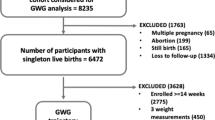Abstract
Background:
The purpose of this study was to examine the effects of gestational weight gain (GWG) and infant feeding practices on infant growth parameters in infants from 6 to 24 mo of age.
Methods:
Forty mother–infant pairs were recruited after delivery and followed up to 24 mo postpartum. GWG was calculated as prepregnancy weight subtracted from weight at delivery. Infant weight velocity was calculated as the change in weight between consecutive visits divided by the intervening time. Infant feeding practices were measured by interview and infant growth and waist circumference by standard anthropometry.
Results:
Infants born to mothers with excess GWG were heavier at birth (3,521 ± 91 vs. 3,196 ± 97 g, P = 0.02) and had an average 2.16 ± 1.1 cm (P = 0.03) larger waist circumference throughout the 24 mo compared with infants born to mothers with appropriate GWG. Waist circumference increased by 0.12 and 2.0 cm for every 1 unit increase in GWG and infant birth weight.
Conclusion:
Infants born to women who exceeded the Institute of Medicine (IOM)-recommended guidelines for GWG were heavier at birth and had a significantly higher waist circumference up to 2 y of age. Strategies to control maternal excess GWG and thus the outcome on infant birth weight and waist circumference should be pursued.
Similar content being viewed by others
Log in or create a free account to read this content
Gain free access to this article, as well as selected content from this journal and more on nature.com
or
References
Ogden CL, Carroll MD, Kit BK, Flegal KM. Prevalence of childhood and adult obesity in the United States, 2011-2012. JAMA 2014;311:806–14.
Catalano PM, Presley L, Minium J, Hauguel-de Mouzon S. Fetuses of obese mothers develop insulin resistance in utero. Diabetes Care 2009;32:1076–80.
Brawarsky P, Stotland NE, Jackson RA, et al. Pre-pregnancy and pregnancy-related factors and the risk of excessive or inadequate gestational weight gain. Int J Gynaecol Obstet 2005;91:125–31.
Baker JL, Michaelsen KF, Rasmussen KM, Sørensen TI. Maternal prepregnant body mass index, duration of breastfeeding, and timing of complementary food introduction are associated with infant weight gain. Am J Clin Nutr 2004;80:1579–88.
Hull H, Baptiste-Roberts K, Salafia C, Brancati F, Gallagher D. Influence of gestational diabetes on the relationship between placental measures and BMI in early childhood. Obesity. 2008;16:S280–S280.
Starling AP, Brinton JT, Glueck DH, et al. Associations of maternal BMI and gestational weight gain with neonatal adiposity in the Healthy Start study. Am J Clin Nutr 2015;101:302–9.
Zilko CE. Economic contraction and birth outcomes: an integrative review. Hum Reprod Update 2010;16:445–58.
Oken E, Rifas-Shiman SL, Field AE, Frazier AL, Gillman MW. Maternal gestational weight gain and offspring weight in adolescence. Obstet Gynecol 2008;112:999–1006.
Reynolds RM, Osmond C, Phillips DI, Godfrey KM. Maternal BMI, parity, and pregnancy weight gain: influences on offspring adiposity in young adulthood. J Clin Endocrinol Metab 2010;95:5365–9.
Schack-Nielsen L, Michaelsen KF, Gamborg M, Mortensen EL, Sørensen TI. Gestational weight gain in relation to offspring body mass index and obesity from infancy through adulthood. Int J Obes (Lond) 2010;34:67–74.
Ziegler EE. Growth of breast-fed and formula-fed infants. Nestle Nutr Workshop Ser Pediatr Program 2006;58:51–9; discussion 59–63.
Butte NF, Wong WW, Hopkinson JM, Smith EO, Ellis KJ. Infant feeding mode affects early growth and body composition. Pediatrics 2000;106:1355–66.
Widen EM, Whyatt RM, Hoepner LA, et al. Gestational weight gain and obesity, adiposity and body size in African-American and Dominican children in the Bronx and Northern Manhattan. Matern Child Nutr 2016; 12:918–28.
Ensenauer R, Chmitorz A, Riedel C, et al. Effects of suboptimal or excessive gestational weight gain on childhood overweight and abdominal adiposity: results from a retrospective cohort study. Int J Obes (Lond) 2013;37:505–12.
Jago R, Mendoza JA, Chen T, Baranowski T. Longitudinal associations between BMI, waist circumference, and cardiometabolic risk in US youth: monitoring implications. Obesity (Silver Spring) 2013;21:E271–9.
Bassali R, Waller JL, Gower B, Allison J, Davis CL. Utility of waist circumference percentile for risk evaluation in obese children. Int J Pediatr Obes 2010;5:97–101.
Savva SC, Tornaritis M, Savva ME, et al. Waist circumference and waist-to-height ratio are better predictors of cardiovascular disease risk factors in children than body mass index. Int J Obes Relat Metab Disord 2000;24:1453–8.
Dewey KG, Heinig MJ, Nommsen LA, Peerson JM, Lönnerdal B. Growth of breast-fed and formula-fed infants from 0 to 18 months: the DARLING Study. Pediatrics 1992;89(6 Pt 1):1035–41.
Kramer MS, Matush L, Vanilovich I, et al.; PROBIT Study Group. Effects of prolonged and exclusive breastfeeding on child height, weight, adiposity, and blood pressure at age 6.5 y: evidence from a large randomized trial. Am J Clin Nutr 2007;86:1717–21.
Catov JM, Abatemarco D, Althouse A, Davis EM, Hubel C. Patterns of gestational weight gain related to fetal growth among women with overweight and obesity. Obesity (Silver Spring) 2015;23:1071–8.
Zemel BS, Riley EM, Stallings VA. Evaluation of methodology for nutritional assessment in children: anthropometry, body composition, and energy expenditure. Annu Rev Nutr 1997;17:211–35.
Institute of Medicine (US) and National Research Council (US) Committee to Reexamine IOM Pregnancy Weight Guidelines. Weight Gain During Pregnancy: Reexamining the Guidelines. In: Rasmussen KM, Yaktine AL, eds. Washington (DC): National Academies Press (US); 2009:1–3.
Acknowledgements
We would like to thank all the mothers and their children who participated in this study, without whom science would not advance. We are grateful to the nursing and research staff of the parent studies, Study of Nutrition and Pregnancy (SNAP) and the Nulliparous Pregnancy Outcomes Study: Monitoring Mothers-to-be (nuMoM2b) (Clinical Trial Number: NCT01322529) for their attention towards subject recruitment.
Author information
Authors and Affiliations
Corresponding author
PowerPoint slides
Rights and permissions
About this article
Cite this article
Michaliszyn, S., Sjaarda, L., Scifres, C. et al. Maternal excess gestational weight gain and infant waist circumference: a 2-y observational study. Pediatr Res 81, 63–67 (2017). https://doi.org/10.1038/pr.2016.174
Received:
Accepted:
Published:
Issue date:
DOI: https://doi.org/10.1038/pr.2016.174


